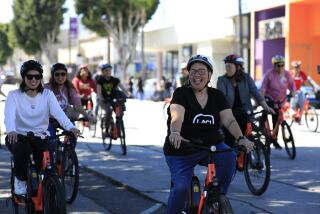Cyclists Get a Big Charge Out of New Bike
- Share via
SEBASTOPOL, Calif. — Except for a square battery pack mounted where the water bottle might go, the ZAP! ElectriCruizer looks like one of those old-fashioned Schwinns your father rode when he was young.
But start pedaling, press the little yellow lever, and without a sound an electric charge powers the bike up to 14 mph. Suddenly, steep hills become a thing of ease. Short trips to the grocery store don’t have to involve a car. Biking to work can be sweat-free. And if you want to slow down or stop, just let up on the lever.
No huffing, no puffing--and no pollution.
Retired engineer Gerry Diamond likes his so much he sold his car.
“A few weeks was all it took me to realize that everything I really wanted to do, I could use a bike,” says Diamond, who lives in Seattle. “By choosing a simpler lifestyle, I find my life is lot less stressful than other people around me.”
ZAP! hasn’t been able to fill orders fast enough since Gary Starr and Jim McGreen began their company five years ago. Now the company has about 50 employees and had made $2.5 million in sales in 1998 before the busy Christmas season.
They’ve sold 22,000 electric bikes, scooters, motorcycles, tricycles and do-it-yourself kits despite scant advertising. They say sales have doubled from 1997, all through word-of-mouth endorsements and a Web site.
There are other electric bikes out there, but the company says only ZAP! bikes can be used with or without electricity, an innovation they say gives them about 80 percent of the market. The battery powers a motor behind the seat that when engaged grips the rear tire and propels the bike forward. An electric bike can travel 15 miles on a single charge costing less than 5 cents.
The biggest downside may be the cost, with ZAP! products ranging in price from $600 for a Zappy scooter to $2,000 for the Electricycle moped.The kit, which the company says can be used to convert almost any bike, costs $375.
Starr had been hoping to market alternatives to gas-powered vehicles since the 1970s oil crunch. McGreen was tinkering with a working model for an electric bike. They decided to go into business after meeting at an electric vehicle association gathering.
“My goal was to make a better bicycle,” says McGreen, who used to ride motorcycles competitively. “Americans own them but don’t ride them.”
They named their company for Zero Air Pollution, headquartered it in this small Sonoma County town and eventually developed several models.
The most popular has been the Zappy, a 35-pound foldable scooter with a handle. The vehicle travels up to 13 mph. The company boasts that it’s small enough to fit in a school locker and, “With practice, you can even do tricks.”
Sebastopol’s eight-man police force was an early ZAP! customer. Today, 150 agencies use them.
“They’re a real good tool for law enforcement,” says Sebastopol policeman Bob Smith. “They enable us to get up to something resembling a traffic speed a lot quicker than just pedaling and without getting pooped out.”
It takes a few hours to charge the batteries, which plug into any outlet and last about 14 miles. The more powerful ZAP! PatrolBikes, used by police, travel up to 20 mph but last only seven miles.
Bicycle shops that cater to tourists are buying ZAP! bikes, and about 20 percent of sales go to foreign customers.
Global warming and noise pollution are important problems, but Starr says his customers buy ZAP! bikes “because they’re cost-effective, practical and fun. Once you get on, you don’t want to get off.”
More to Read
Sign up for The Wild
We’ll help you find the best places to hike, bike and run, as well as the perfect silent spots for meditation and yoga.
You may occasionally receive promotional content from the Los Angeles Times.






